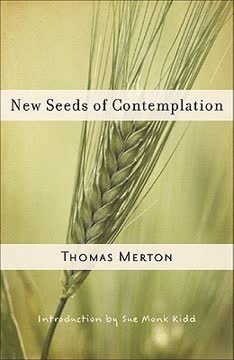Key Takeaways
1. Monastic Life: A Quest for God Through Solitude and Simplicity
A monk is a man who has been called by the Holy Spirit to relinquish the cares, desires and ambitions of other men, and devote his entire life to seeking God.
Essence of monastic vocation. The monastic life is fundamentally a radical response to the call of God, requiring a complete reorientation of one's life. Monks seek to detach themselves from worldly concerns and material pursuits to focus entirely on their relationship with the Divine.
Simplicity and solitude. These are key elements of the monastic path:
- Simplicity in lifestyle, possessions, and daily routines
- Solitude as a means to cultivate inner silence and receptivity to God
- Withdrawal from secular society to create space for spiritual growth
The monastery serves as a "tabernacle in the desert," a sacred space set apart for the pursuit of union with God. This environment fosters a life of prayer, contemplation, and spiritual transformation.
2. The Essence of Monasticism: Renunciation and Self-Transformation
The monk puts these things aside, though they may be good. He travels to God by the direct path, recto tramite.
Radical renunciation. At the core of monasticism is the willingness to give up not only sinful or harmful things, but even good and noble pursuits for the sake of single-minded devotion to God. This includes:
- Renouncing family life and personal relationships
- Giving up career ambitions and material security
- Surrendering personal autonomy through obedience
Self-transformation. The goal of monastic renunciation is not mere asceticism, but profound inner change:
- Purification of the heart from selfish desires and attachments
- Cultivation of virtues like humility, charity, and patience
- Growth in spiritual maturity and Christ-likeness
The monastic journey involves a gradual dying to self and rebirth in Christ, as the monk seeks to empty himself of ego and be filled with divine love and wisdom.
3. Contemplative Prayer: The Heart of Monastic Spirituality
Faith is the light which illumines him in mystery. Faith is the power which seizes upon the inner depths of his soul and delivers him up to the action of the divine Spirit, the Spirit of liberty, the Spirit of love.
Centrality of prayer. Contemplative prayer forms the core of monastic life and spirituality:
- Liturgical prayer (Divine Office) structures the day
- Lectio Divina (sacred reading) nourishes the mind and heart
- Silent meditation fosters interior receptivity to God
Mystical dimension. Monastic prayer aims beyond mere petition or reflection to mystical union with God:
- Cultivation of an experiential knowledge of the Divine
- Openness to direct guidance by the Holy Spirit
- Transformation of consciousness through divine grace
The monk's entire life becomes a living prayer, as all activities are oriented toward communion with God and permeated by His presence.
4. Benedictine Tradition: Balancing Community and Solitude
The monk's whole day, in the silence of his cell, or of his garden looking out upon the forest, is a prolonged Communion.
Cenobitic framework. St. Benedict's Rule provides a balanced approach to monastic life:
- Community life as a school of charity and mutual support
- Structured daily routine of prayer, work, and study
- Emphasis on stability and commitment to a particular community
Space for solitude. Within this communal structure, Benedict allows for:
- Periods of silent prayer and meditation
- Individual spiritual reading and reflection
- Possibility of greater solitude for mature monks
The Benedictine way seeks to cultivate both the virtues of community life and the depths of personal contemplation, recognizing that both contribute to spiritual growth.
5. Cistercian Reform: Austerity and Charity in Pursuit of Christ
The Cistercian life is the attempt to plumb all the depths of the theology of the Gospel and Epistle of St John, who said "Everyone that loveth is born of God, and knoweth God."
Return to simplicity. The Cistercian reform sought to restore the original austerity of the Benedictine life:
- Emphasis on manual labor and self-sufficiency
- Simplification of liturgy and architecture
- Stricter observance of silence and solitude
Mystical charity. Cistercian spirituality, especially as articulated by St. Bernard, emphasizes:
- The centrality of love in the spiritual life
- Mystical union with Christ as the goal of monastic striving
- Transformation of the monk into the likeness of Christ
The Cistercian way combines rigorous asceticism with a profound mystical theology, seeking to strip away all that is not essential in order to focus entirely on love for God and neighbor.
6. Carthusian Way: Radical Solitude and Silence for Divine Union
The Carthusian life is notable above all for its single-minded insistence on silence and solitude.
Eremitical focus. The Carthusian Order represents the most radical expression of the eremitical ideal in Western monasticism:
- Monks live in individual cells/cottages
- Minimal community interaction and vocal prayer
- Emphasis on silent contemplation and inner transformation
Preservation of tradition. The Carthusians are renowned for:
- Maintaining their original observance without reform
- Resisting external pressures for change or modernization
- Providing a living link to ancient monastic traditions
The Carthusian way offers a uniquely intense and uncompromising path of contemplative prayer, attracting those called to the deepest solitude and silence.
7. Camaldolese Life: Bridging Eremitic and Cenobitic Traditions
The singular advantage of such a life is that it makes it possible for a pure contemplative life of real solitude and simplicity, without formalism and without rigid, inflexible prescriptions of minor detail, yet fully protected by spiritual control and by religious obedience.
Flexible approach. The Camaldolese Order uniquely combines:
- A cenobitic monastery for formation and support
- An eremitical community of individual hermitages
- Possibility of complete reclusion for mature monks
Balanced spirituality. Camaldolese life emphasizes:
- Solitude and silence as primary means of contemplation
- Communal support and obedience for stability
- Flexibility in adapting practices to individual needs
This approach allows for a gradual progression in the contemplative life, accommodating different levels of spiritual maturity and personal calling within a single monastic family.
8. Manual Labor and Intellectual Work in Monastic Life
Every monk is, or should be, a special kind of artist.
Dignity of work. Monastic tradition values manual labor as:
- A form of asceticism and self-discipline
- A means of supporting the community
- An expression of creativity and craftsmanship
Intellectual pursuits. Many monastic orders also emphasize:
- Study of Scripture and theology
- Preservation and transmission of knowledge
- Artistic and literary creation
The balance between manual and intellectual work varies among orders and individual monasteries, but both are seen as integral to monastic formation and service to the Church and society.
9. Monastic Humility: The Foundation of Spiritual Growth
The victory of monastic humility is the full acceptance of God's hidden action in the weakness and ordinariness and unsatisfactoriness of our own everyday lives.
Core virtue. Humility is considered essential to monastic life:
- Recognition of one's total dependence on God
- Willingness to learn from others and accept correction
- Freedom from pride, ambition, and self-will
Spiritual fruits. True humility leads to:
- Openness to divine grace and guidance
- Growth in charity and compassion for others
- Interior peace and spiritual maturity
Monastic tradition sees humility not as self-abasement, but as a realistic self-knowledge that opens the way to authentic transformation in Christ.
10. The Role of Obedience and Discipline in Monastic Formation
The monk who feels himself to be most destitute in virtue and in grace can be rich in both if he has the humility and charity to share the virtues of his brothers by rejoicing in them as if they were his own.
Obedience as freedom. Monastic obedience is understood as:
- Surrender of self-will to align with God's will
- A school of humility and self-knowledge
- A means of transcending individualism and entering into community
Disciplined life. Monastic observance provides:
- A structured framework for spiritual growth
- Regular practices to cultivate virtue and mindfulness
- Protection against the instability of human nature
The goal of monastic discipline is not mere conformity, but the formation of mature spiritual freedom rooted in love for God and neighbor.
11. Monastic Peace: Beyond Material Comfort to Spiritual Freedom
The peace of the monk is proportionate to his detachment from the things of earth.
Interior freedom. True monastic peace comes from:
- Letting go of attachments to material possessions
- Overcoming the tyranny of passions and desires
- Cultivating trust in divine providence
Spiritual fruitfulness. This peace manifests as:
- Joy and contentment independent of external circumstances
- Increased capacity for compassion and service
- Deeper union with God and openness to His grace
The monk seeks a peace that transcends worldly security, finding rest in God alone and becoming a channel of His peace to others.
Last updated:
FAQ
1. What is "The Silent Life" by Thomas Merton about?
- Exploration of Monasticism: "The Silent Life" is a comprehensive meditation on the monastic life, exploring its spiritual, historical, and practical dimensions.
- Definition of a Monk: Merton defines a monk as someone called by the Holy Spirit to seek God exclusively, relinquishing worldly desires and ambitions.
- Monastic Orders and Traditions: The book examines various monastic orders, including Benedictines, Cistercians, Carthusians, and Camaldolese, detailing their unique practices and spiritual emphases.
- Inner Spiritual Journey: Merton delves into the inner transformation and mystery of seeking God, emphasizing purity of heart, humility, and contemplative prayer as central to monastic life.
2. Why should I read "The Silent Life" by Thomas Merton?
- Insight into Monastic Spirituality: The book offers a rare, insider’s perspective on the purpose and meaning of monastic life, making it valuable for anyone interested in spirituality or religious history.
- Accessible and Reflective: Merton’s writing is both accessible and deeply reflective, making complex spiritual concepts understandable to a broad audience.
- Relevance Beyond Monasteries: The themes of silence, self-renunciation, and seeking God are presented as relevant not only to monks but to all who desire a deeper spiritual life.
- Authoritative Voice: As a Trappist monk and acclaimed spiritual writer, Merton brings authenticity and depth to his exploration of monasticism.
3. What are the key takeaways from "The Silent Life" by Thomas Merton?
- Monastic Life as Seeking God: The essence of monasticism is the exclusive and total search for God, rooted in love, humility, and self-renunciation.
- Purity of Heart: Achieving "puritas cordis" (purity of heart) is central, involving the stripping away of illusions, pride, and self-will to become truly free and united with God.
- Community and Solitude: Monastic life balances communal living (cenobitism) and solitude (eremitism), each fostering spiritual growth in unique ways.
- Practical Spirituality: The book emphasizes that monastic practices—prayer, labor, silence, and obedience—are not ends in themselves but means to inner transformation and charity.
4. How does Thomas Merton define a monk in "The Silent Life"?
- Man of God: A monk is described as a "man of God," called to seek God because he has already been found by God.
- Exclusive Dedication: Unlike other religious vocations, the monk is exclusively dedicated to seeking God, not to active ministry or seeking souls for God.
- Direct Path to God: The monk takes the "direct path" to God, setting aside even good worldly pursuits to focus entirely on prayer, meditation, and self-denial.
- Martyrdom and Paradise: Merton characterizes the monastic life as both a "martyrdom" and a "paradise," involving self-sacrifice and the joy of divine union.
5. What is "purity of heart" (puritas cordis) in "The Silent Life" by Thomas Merton?
- Central Monastic Goal: Purity of heart is the primary aim of monastic life, representing a state of inner transformation and perfect charity.
- Freedom from Illusion: It involves freeing oneself from pride, self-centeredness, and the illusion of self-omnipotence, leading to true humility and openness to God.
- Integration and Simplicity: A pure heart brings unity within oneself and with others, simplifying life and enabling genuine love and community.
- Means, Not Ends: Monastic practices like solitude, poverty, and obedience are valuable only insofar as they foster this inner purity.
6. How does "The Silent Life" by Thomas Merton describe the balance between solitude and community in monasticism?
- Cenobitic and Eremitic Life: Merton explains the distinction and interplay between cenobitic (communal) and eremitic (solitary) monasticism, both rooted in the search for God.
- Community as Support: The monastic community provides support, accountability, and shared purpose, helping individuals grow in charity and humility.
- Solitude for Contemplation: Solitude is valued for fostering deep prayer and direct encounter with God, with some orders (like Carthusians and Camaldolese) emphasizing it more.
- Mutual Enrichment: Even hermits remain spiritually connected to the community, and communal life is enriched by the contemplative depth of its solitaries.
7. What are the main monastic orders discussed in "The Silent Life" by Thomas Merton, and how do they differ?
- Benedictines: Emphasize balance, moderation, and the Rule of St. Benedict, blending prayer, work, and study in community.
- Cistercians (Trappists): Seek a return to the original austerity and simplicity of Benedictine life, focusing on poverty, manual labor, and contemplative prayer.
- Carthusians: Live as hermits in community, prioritizing silence, solitude, and strict separation from the world.
- Camaldolese: Combine cenobitic and eremitic traditions, offering both communal and solitary paths, with a strong emphasis on contemplative solitude.
8. How does "The Silent Life" by Thomas Merton address the role of work and daily life in the monastery?
- Work as Prayer: Manual labor is seen as integral to monastic life, not just as penance but as a means of serving God and the community.
- Respect for Material Things: Monks are taught to treat even humble objects with reverence, seeing all creation as belonging to God.
- Balance of Activities: The daily schedule balances prayer, work, and study, with each activity ordered toward fostering recollection and union with God.
- Art and Craftsmanship: Artistic and intellectual work are valued when they arise from and contribute to the spirit of prayer and humility.
9. What is the significance of silence in "The Silent Life" by Thomas Merton?
- Silence as Spiritual Atmosphere: Silence is essential for fostering interior recollection, prayer, and openness to God’s presence.
- Means to Purity and Wisdom: Through silence, monks learn self-control, humility, and the ability to listen deeply to God and others.
- Protection from Distraction: Silence guards against the distractions and noise of the world, creating space for contemplation and spiritual growth.
- Not Mere Absence of Speech: True silence is not just the absence of words but an active, receptive state that enables the soul to encounter God.
10. How does "The Silent Life" by Thomas Merton explain the relationship between monasticism and the wider world?
- Hidden Influence: Monks, though withdrawn from the world, act as a spiritual "yeast," influencing society through prayer and example.
- Solidarity with Humanity: The monastic vocation is not escapism; monks remain spiritually involved in the world’s struggles and sufferings.
- Witness to Transcendence: The monastery stands as a sign of the primacy of the spirit and the reality of God’s mercy in a materialistic age.
- Responsibility and Detachment: Monks are called to represent God in the world, maintaining detachment from worldly factions while embodying charity and compassion.
11. What are some of the best quotes from "The Silent Life" by Thomas Merton, and what do they mean?
- "A monk is a man who seeks God because he has been found by God." This highlights the paradoxical nature of the monastic vocation as both a response to and a search for divine encounter.
- "The monastic life is nothing but the life of those who have taken the first commandment in deadly earnest." Merton emphasizes the radical commitment to love God above all else.
- "Purity of heart is the condition of a soul transformed in perfect charity." This quote encapsulates the goal of monastic asceticism—not external perfection, but inner transformation.
- "The monastery is a tabernacle in the desert, upon which the shekinah, the luminous cloud of the divine Presence, almost visibly descends." Merton poetically describes the monastery as a place of God’s special presence, set apart for contemplation.
12. How does "The Silent Life" by Thomas Merton address the challenges and potential pitfalls of monastic life?
- Professional Hazards: Merton acknowledges that monks can fall into self-preoccupation, pride, or sterile routine if they lose sight of their true purpose.
- Temptation to Superiority: The desire to be "better than everybody else" is identified as a major enemy of purity of heart and true humility.
- Need for Discretion and Balance: Excessive austerity or rigidity can be as harmful as laxity; true monasticism requires wisdom, flexibility, and compassion.
- Continuous Conversion: The monastic journey is ongoing, requiring constant self-examination, acceptance of weakness, and reliance on God’s mercy.
Review Summary
The Silent Life receives mixed reviews, with an average rating of 4.07/5. Many readers appreciate Merton's insights into monastic life and spiritual pursuits, finding the book informative and inspiring. Some praise his writing style and depth of knowledge. However, others find it too academic or dogmatic, especially in the beginning. The book is seen as a valuable resource for those interested in monasticism but may not appeal to casual readers expecting a guide to personal contemplation. Some reviewers note its historical significance in explaining various monastic orders.
Similar Books
Download PDF
Download EPUB
.epub digital book format is ideal for reading ebooks on phones, tablets, and e-readers.












